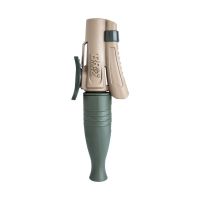
Scrape signposts are often mentioned in hunting literature and on entertainment television. While some hunters consider them paramount, others dismiss them as secondary locations. Over half of the bucks I’ve arrowed were taken from active scrape areas, so I consider them major focal points of buck activity throughout all phases of the rut.
Unfortunately, the trouble many hunters have with scrape hunting is self-inflicted. Scrape hunting failure is primarily due to faulty recognition of a scrape area suited for daytime visits. However, improper setups and poor timing can also cause scrape hunting failure.
Scrapes are tools for social interactions, but they also indicate territorial and dominance markers and breeding calling cards. Overhanging licking branches are the primary source of communication between all local deer. Bucks and does mark licking branches with scent from forehead glands, pre-orbital and nasal glands, and saliva, while the scrape itself is scent marked with interdigital glands and urine.
Bucks make scrapes in open areas with lots of doe activity. These include feeding destinations like mast and fruit trees, crop field perimeters, pinch points in transition zones, and where differing terrain features converge. Some scrapes are traditional—deer use them year after year, but others can change according to crop rotations and mast or fruit production. Multiple licking branches over a scrape are indicators that the scrape gets revisited. On occasion, there might be just one large-diameter licking branch.
So where, why, and when does scrape hunting become your best bet at taking mature bucks? The million-dollar question should be: Does the scrape location have adequate security cover requirements for a daytime visit? That question is based on the amount and type of hunting pressure the area receives. Without first addressing hunting pressure, there is no “one size fits all” answer to any questions regarding daytime whitetail movements and social habits.
The Pressure is On Just as feelings of vulnerability affect our security precautions and movement habits, the amount and type of hunting pressure will affect a mature buck’s chances of survival, movement habits, and the conditions under which they would revisit signposts during daylight.
In heavily pressured areas, scrape areas must offer both perimeter security cover and transition security cover to a known bedding area to see daytime mature buck activity. Otherwise, you should disregard these as hunting locations. Due to other hunters’ pre-season ventures and early season hunting, after the first two days of the season, most mature bucks will have turned nocturnal. I wouldn’t advise hunting a scrape area beyond then, active or not. Do not return until the rut phases begin.
In lightly hunted and managed areas, mature bucks will move into open areas during daylight. This activity is evident when watching television shows and videos where mature bucks are commonly taken in open areas.
The Scrape Timeline Active scrapes can show up under mast and fruit trees in early September. If the location offers enough security cover requirements, it should be set up and left alone until the first few days of the season have come and gone. Additional pre-season visits are the same as hunting visits—a mature buck can’t differentiate between hunting and scouting. He will view your human activity as a threat to his existence which will cause him to turn nocturnal or avoid the area during daylight.
Hunting scrapes during the October lull will drive daytime doe traffic away from the area. Never forget that all mature buck activity during the rut phases revolves around areas with unaltered doe activity. In late October, I begin focusing on scrape areas during pre-rut and continue to hunt them only during evenings if they are food destination locations.
No matter the location, your first pre-rut hunt should take place early in the afternoon when you can inspect the scrape area for activity. If it’s not active, but you see other deer activity nearby, use a stick to clear one of the old scrapes and place several drops of doe-in-estrus and buck urine in it and leave. Your early arrival allows you to hunt elsewhere. Return in several days return and be ready to hunt the revived scrape if it’s active.
Primary scrapes are food destination locations, which means you should only hunt them in the evening. You would spook any attending deer with morning entries. After an evening hunt, I will often slide out of my saddle and leave as quietly as possible, leaving my bow in the tree. This move saves departure time and morning setup time and will guarantee that I show up.
Be the Early Bird On morning hunts, it’s imperative to be on stand an absolute minimum of an hour and a half before dawn. If possible, remain on the stand until 3:00 p.m., if not all day. Pressured mature bucks will generally transition into their bedding area before daybreak, and you should be on stand and quiet so as not to spook him. Otherwise, without knowing it, you may spook him with a normal entry time. If your entry spooks him, the likelihood of seeing him later in the morning or during midday is near zero.
Primetime during the rut phases is between 11:00 a.m. and 3:00 p.m. In heavily pressured areas, midday movements are often a mature buck’s only point of vulnerability, so be ready to plan your whole day around those few hours.
Ultimately, scrape areas are high doe traffic areas, making them the best locations to intercept an amorous buck when the conditions are right. But timing and a proper setup are imperative, too. Don’t leave for a day in the stand without taking all of these factors into consideration.
Feature image via Matt Hansen.







